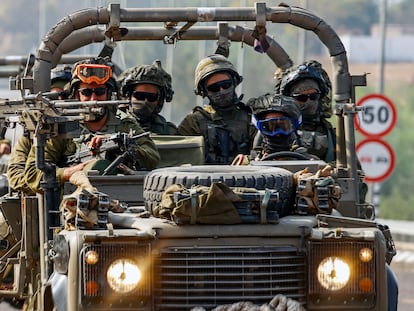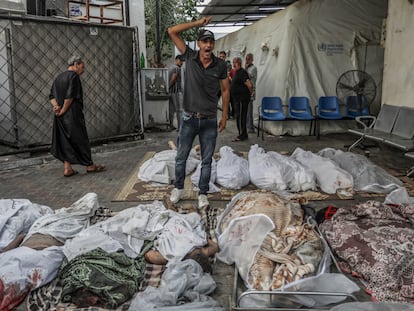Israeli airstrike kills dozens at Gaza refugee camp
Authorities in the Strip announced that, for the first time since the beginning of the conflict, wounded Palestinians will receive medical treatment in Egypt. An attack by the Huthi — Yemeni allies of Iran — on the Israeli Red Sea coast fuels the risk of a regional war
While Israel’s army continues its advance into Gaza, on Tuesday an Israeli strike killed dozens of people in Jabaliya, the largest refugee camp in the Palestinian enclave. The bombardment left a huge crater and seriously damaged a dozen buildings, from which residents had to pull out — with their bare hands — the corpses of adults and babies, as could be seen in images and videos aired on television. The Israel Defense Forces (IDF) claimed that the airstrike was aimed at a Hamas underground operations center and that it killed the commander of a local battalion of the armed group, Ibrahim Biari.
Al Jazeera broadcast live from the site of the bombing of the Jabaliya refugee camp, with footage that showed residents carrying out the bodies of at least three babies and dozens of locals searching for survivors and pulling bodies from the rubble, several of them apparently lifeless. At a press conference, Israeli military spokesman Daniel Hagari blamed Hamas leader Yahia Sinwar for the civilian deaths in the shelling, saying they were used as “a human shield,” and reiterated the call for residents of the area to move south “for their protection.”
The director of the nearby Indonesia Hospital, where bodies recovered from Jabaliya are being taken, and the Hamas-run Ministry of Health in Gaza have put the initial number of dead at 50 and the number of wounded at 150. Although this is one of the most lethal strikes of the war thus far, it does not significantly change the death toll, which is increasing by the hundreds of Palestinians every day. Since Hamas attacked Israel on October 7, 8,530 Palestinians have been killed, most of them women and children, in addition to the 21,541 which have been left wounded, according to the Gaza Ministry of Health. In a statement, James Elder, a spokesperson for UNICEF, described Gaza as a “graveyard for thousands of children” and “a living hell for everyone else.”
Israel presses into Gaza
Among the very measured information being made public about Israel’s ongoing invasion of Gaza, a video shot inside the enclave shows a Merkava tank in Salah al-Din, the main highway of the Strip. The tank is seen opening fire on a car speeding away. The Salah al-Din Road is the route being used by hundreds of thousands of residents of northern Gaza to evacuate south, as the Israeli army has repeatedly instructed them to do. The videos (in black and white and edited) released by the IDF do not show armored vehicles in that area. The location of the Israeli tank appears to show an attempt at cutting off the north of the Strip from the south, where the vast majority of the population is located now.
The Israeli army claimed it hit “300 targets” in the last 24 hours, in which it killed “dozens of terrorists.” For its part, Hamas’ armed wing, Izz ad-Din al-Qassam Brigades, reported clashes with Israeli ground forces, in which it lost an unspecified number of men. “The occupation is pushing its soldiers into proud Gaza, which will always be the cemetery of invaders,” Hamas said in a statement.
Earlier on Tuesday, Israel reported that two of its soldiers had been killed in clashes with Hamas militants, the first Israeli fighters to die since the invasion of Gaza began last Friday.
Gaza’s ‘public health catastrophe’
Also on Tuesday, Israel announced a plan allegedly underway for wounded Palestinians to be treated in floating medical centers on the southern coast of Gaza, and not in the hospitals of the northern zone, which it ordered to evacuate but where there are still hundreds of thousands of people. At a press conference in Tel Aviv, Israeli National Security Advisor Tzaji Hanegbi said Gazan civilians should be treated in “alternative hospitals in Egypt, in the protected area [in Gaza], [and] on hospital ships of various countries who answered the prime minister’s initiative and are meant to reach Gaza’s shores.” He added: “But not in hospitals that today are effectively terror headquarters for Hamas and Islamic Jihad command and control.”
Additionally, the General Authority for Crossings and Borders in Gaza said Egyptian authorities told it that 81 Gazans who were severely wounded will be allowed to enter Egypt on Wednesday to receive medical treatment, as reported by Reuters. If that does occur, it will be the first group of people evacuated from Gaza through the Rafah crossing, which connects Gaza with Egypt, since the clash between Hamas and Israel began on October 7. Cairo, which fears a wave of refugees will storm the border barrier (the only one inside Gaza that does not face Israel), is placing armored vehicles near the crossing.
The World Health Organization (WHO) warned Tuesday of the “public health catastrophe” that is looming over the people of Gaza due to overcrowding caused by the massive displacement of the population, as well as the damage caused by Israeli bombardment against local water and sanitation infrastructures. UNICEF also warned that cases of dehydration have already been reported among Palestinian children and estimates that there may be close to a thousand children missing.
The growing risk of a regional conflict
Tuesday’s events also made evident once again the growing risk of the conflict expanding regionally. While Israel’s main fear is that the better armed and prepared Lebanese Hezbollah militia will launch a substantial attack on its northern border — strikes out of Lebanon thus far have been limited — another ally of Iran, Yemen’s Houthi rebels, launched missiles and drones against Eilat, the coastal city in southern Israel where some 60,000 people have been relocated. The Houthi rebels, who control a large part of Yemen (including the capital), warned that they will launch more strikes in support of their “oppressed brothers in Palestine.”
The Israeli army claims to have intercepted a ground-to-ground missile, launched from the Red Sea area, before entering its territory, as well as “aerial threats flying in the area” that set off anti-aircraft alarms in the city of Eilat, right on the border with Jordan and Egypt, and very close to Saudi Arabia. “There was no threat or risk to the civilian population,” a military spokesperson said.
Previously, on the October 19, a U.S. warship intercepted three cruise missiles and several drones launched from Yemen into Israel, according to the Pentagon. And Israel previously linked the Huthi rebels to another drone attack that caused injuries in neighboring Egypt.
Sign up for our weekly newsletter to get more English-language news coverage from EL PAÍS USA Edition
Tu suscripción se está usando en otro dispositivo
¿Quieres añadir otro usuario a tu suscripción?
Si continúas leyendo en este dispositivo, no se podrá leer en el otro.
FlechaTu suscripción se está usando en otro dispositivo y solo puedes acceder a EL PAÍS desde un dispositivo a la vez.
Si quieres compartir tu cuenta, cambia tu suscripción a la modalidad Premium, así podrás añadir otro usuario. Cada uno accederá con su propia cuenta de email, lo que os permitirá personalizar vuestra experiencia en EL PAÍS.
¿Tienes una suscripción de empresa? Accede aquí para contratar más cuentas.
En el caso de no saber quién está usando tu cuenta, te recomendamos cambiar tu contraseña aquí.
Si decides continuar compartiendo tu cuenta, este mensaje se mostrará en tu dispositivo y en el de la otra persona que está usando tu cuenta de forma indefinida, afectando a tu experiencia de lectura. Puedes consultar aquí los términos y condiciones de la suscripción digital.
More information
Archived In
Últimas noticias
Mexico seeks to shore up its defenses following US incursion in Venezuela
Hope gives way to uncertainty among Venezuelan exiles in the US after Maduro’s capture
Cubans look to Venezuela fearfully after Trump’s incursion: ‘We could be next’
The operation in Venezuela to capture Maduro threatens to widen the cracks in the MAGA movement
Most viewed
- Alain Aspect, Nobel laureate in physics: ‘Einstein was so smart that he would have had to recognize quantum entanglement’
- Alvin Hellerstein, a 92-year-old judge appointed by Bill Clinton, to preside over Maduro’s trial in New York
- Gilles Lipovetsky: ‘If you want to live better and fall in love, take Prozac, don’t look to philosophy’
- Cuba confirms death of 32 of its citizens in the US attack against Venezuela
- Why oil has been at the center of Venezuela-US conflicts for decades











































